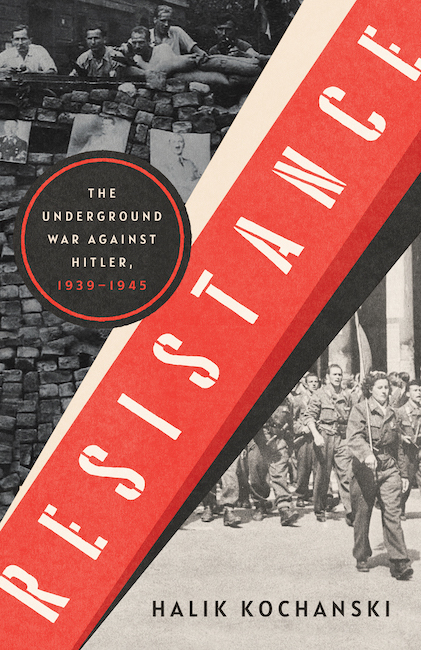On the silver screen, resistance to the Nazis is often painted as a splashy, violent affair. Think Inglourious Basterds, Quentin Tarantino’s 2009 alternate history of the Second World War, complete with stylised, over-the-top gore.
But even with the knowledge that the film is not meant to be taken literally, there is something satisfying about the symbol of armed resistance. It dovetails nicely with the War epic, where any setbacks or losses are set against the overarching narrative of the goodies triumphing over the baddies.

In her latest book, Resistance: The Underground War in Europe, 1939-1945 (Allen Lane, March 2022), the British historian Halik Kochanski dispels the myth that all resisters, or even the majority, were armed. Instead, she presents a detailed chronological overview of opposition to the Nazis across the continent, beginning at a time when, for a large swathe of Europeans, resistance was something to be considered rather than acted upon. Even as the war progressed, most civilians never took up arms.
“I wanted to show the chronology because I think that often gets missed,” she tells The Parliament. “When people hear the word resistance, they automatically assume armed resistance. Well, armed resistance only really began in 1943. I was always curious what happened earlier.”
This approach allows Kochanski to avoid the pitfalls of nationalist historiographies of the subject, which can trade in a degree of mythmaking. It is an understandable response, in Kochanski’s opinion, as each country needed to wipe away the stain of defeat by claiming they resisted the Nazis and liberated themselves, even where such protestations are doubtful.
“The national perspective leads people to say, ‘My country was the only country to do this, or my country was the first country to do this.’ And that’s never quite true,” she explains.
By zooming out and considering occupied Europe as a whole, Kochanski recognises a very clear divide between eastern and western Europe in terms of German policies and the actions of the resistance. From the beginning, Adolf Hitler’s violent settlement of Poland stands in stark contrast to the Nazi collaboration with the Vichy regime in France, for instance.
“As the Germans said, in the east we have a mission, in the west we have a function. The mission in the east was Lebensraum [“living space”, the German concept of settler colonialism], and in the case of Poland, the total destruction of the state and the enslavement of its population,” Kochanski says. “The country was to be nothing more than a giant reservoir of labour for the Germans.”
Given this brutality, which Kochanski documented in her 2012 book The Eagle Unbowed: Poland and the Poles in the Second World War, the Poles had no option but to resist. “Even the Germans admitted that the Poles resisted from the first day to the last day,” she says.
If you knew that every day when you left your house, you might not come back, there was nothing left to lose. As she puts it, “there was such terror imposed by the Germans in eastern Europe that in the end, terror lost its power to terrorise.”
In contrast, in western Europe, collaborating governments positioned themselves as a shield between the Nazis and their citizenry, ensuring that life could mostly carry on as (relatively) normal. Individuals and small groups contributed to the resistance by rescuing trapped Allied servicemen, providing intelligence to the Allies and setting up a clandestine press, but the majority took a wait-and-see approach.
The German invasion of the Soviet Union and its failure to take Moscow by December 1941, however, paved the way for the introduction of two key policies, at least in terms of making resistance more attractive: the Holocaust and forced labour in western Europe. “So many young people fled into the forests. Not all of them planned to be resisters, but it forced the resistance to become better organised because these people needed to be fed and sheltered somehow,” Kochanski says. It also made it harder to swallow the falsehood that the collaborators were working on their behalf.
 Halik Kochanski | Photo: Joseph Bruno
Halik Kochanski | Photo: Joseph Bruno
As opposition grew across the continent and it was no longer a foregone conclusion that the Germans would win the war, similar questions began to crop up. How do you decide to trust someone? Who is the enemy? Who is in control?
Many of these lessons had to be learnt time and time again. The Comet escape line, which ran from Brussels down to Anglet, a small coastal town in France close to the Spanish border, suffered many disasters over the years and yet continued to be rebuilt. “These were largely women who were operating the line, often using school children to skip ahead of [and so lead] the airmen who were being moved,” Kochanski explains. “And yet people always came forward. It’s the sheer resilience of the resistance that is just so admirable.”
This is one of many examples illustrating the power of unarmed resistance. Another was found in Norway, where the war-time leader and Nazi collaborator Vidkun Quisling was stymied by the local population at every turn. When he tried to Nazify the church, all the deacons resigned. When he tried to Nazify the legal system, the Supreme Court resigned. Workers in a wide variety of industries went on strike. And all these acts of civil disobedience occurred without a shot being fired.
In the hyperconnected present, it is easier for intelligence and resources to be shared, and yet opposition doesn’t necessarily feel any more straightforward; the problems at hand often appear too amorphous or diffuse or systemic to oppose in a meaningful way.
Yet winning what the resistance called the “battle of the mind” is still crucial – perhaps even more so. The aim, according to Kochanski, was to show the true impact of the Nazi occupation and to tell the truth at all times. That way, “people can remember that there is an alternative and that the future may not be like the present,” she says. “I think that still works today with all the different forms of communication and fake news. If anything, it’s even more important to win that battle.”
Sign up to The Parliament's weekly newsletter
Every Friday our editorial team goes behind the headlines to offer insight and analysis on the key stories driving the EU agenda. Subscribe for free here.